Understanding Jesus’ Miracles


That Jesus was a miracle worker is central to the Christology of the New Testament Gospels and Acts. In Mark, the earliest Gospel, 17 stories of miracles appear in the first eight chapters. Most of the stories are repeated by Matthew and Luke. In Peter’s Pentecost speech, he recalls Jesus’ ministry by saying that Jesus was “a man designated … by God with deeds of power, wonders, and signs that God did through him” (Acts 2:22). Some scholars tell us that a so-called Signs Source was incorporated into the Gospel of John, according to which 12 signs or miracles are recounted in chapters 1 through 12. The ending of the original Gospel of John even assures the reader that Jesus “did many other signs in the presence of his disciples, which are not written in this book” (John 20:30; chapter 21 was added later).
How are we to understand the miracles Jesus performs, as related in the New Testament? This is not the same as asking whether they happened. Some may have happened; others should probably be interpreted symbolically.
But all the miracle stories impart a theological lesson. That is why they are there. This message is what we are to understand from them.
The miracles do not suffice to prove Jesus’ divinity, for not only Jesus can perform miracles, as the New Testament itself tells us. Jesus acknowledges his opponents’ ability to expel demons (Matthew 12:27//Luke 11:19). False prophets and messianic pretenders also work miracles (Matthew 7:15–23, 24:24). Therefore Jesus’ miracles are not merely to prove that Jesus is the messiah. The miracles in the New Testament are ambiguous; they have to be interpreted.
We may divide Jesus’ miracles into two types: (1) nature miracles and (2) healing miracles. It is important to understand that both types were part of the ancient landscape: they were unusual, but not uncommon.
Israelite-Jewish tradition tells of miracle workers. Biblical heroes such as Moses, Elijah and Elisha are said to have performed wondrous feats—bringing forth water from a rock, feeding multitudes, curing lepers, and raising the dead (Exodus 15; 1 Kings 17:17–24; 2 Kings 4, 5:1–14).
The first-century C.E. Jewish historian Flavius Josephus describes several Jewish miracle workers around the turn of the era. A certain Eleazar expelled a demon in the presence of the Roman emperor Vespasian (who was also said to be a miracle worker). Eleazar commanded the demon to overturn a nearby bowl of water, proving that the demon had in fact left the man.1
Honi, a certain Galilean charismatic, is said to have made it rain after a long rainless period. Whereas Josephus says he did this simply by praying,2 the Mishnah, an early rabbinic text, says he drew a circle and adjured God that he would not move from the circle until it had rained.3
Another Galilean charismatic, Hanina ben Dosa, was a famous healer. When the son of his community leader, Yohanan ben Zakkai, was taken ill, Yohanan said to the healer, “Hanina, pray for my son that he may live!” Hanina put his between his knees and prayed—and the boy was made well.4
Hanina could even cure from a distance. When Rabban Gamaliel’s son was afflicted with a very high fever, students were sent to Hanina’s home in Galilee. Hanina went into his chamber, prayed, and upon returning, said, “Go home, his fever has departed from him.” When the students came back, Gamaliel confirmed that his son had been cured.5
Jesus also was able to heal from a distance. In the story of the healing of the servant of the Roman centurion, Jesus pronounces the cure without having entered the officer’s home and without having seen the servant. “And the servant was healed in that hour” (Matthew 8:13).
The Greeks too had their healers. As early as the fifth century B.C.E., the Greek philosopher Empedocles was known as a great healer as well as a prophet. Speaking about the various people coming to see him, Empedocles says, “Some come in order to hear prophecies, while others—who have been tormented by great pains for a long period—beg to hear the word which cures all kinds of illness.”6
One of the most famous miracle workers of the first century C.E. was Apollonius of Tyana, a city in the province of Cappadocia in Asia Minor. On one occasion, he drove out a demon who had taken possession of a young man. The youth’s symptoms are described in Apollonius’s biography written in the first part of the third century: “He would laugh at things that no one else laughed at, and he would talk and sing to himself.” Apollonius expelled the demon with a look and a command:
“When Apollonius gazed on him, the demon in him began to utter crises of fear and rage … and the demon swore that he would leave the young man and never take possession of anyone again. But Apollonius addressed him with anger … and he ordered him to leave the young man and show by a visible sign that he had done so. ‘I shall throw down that statue,’ the demon said, and pointed to one of the images which was in the king’s portico.”
The statue began to rock, finally falling down. Everyone “clapped their hands with wonder.” The young man was instantaneously cured and, what is more, “fell in love with the austerity of philosophers.”7
In short, while miracles were not everyday phenomena, they did not contradict the ancient understanding of the laws operative in nature.
Some ancient miracles do not necessarily require a symbolic interpretation. Jesus’ healing miracles fall into this category. The history of medicine is full of examples of instantaneous hypnotic cures. Even a rare and congenital skin disease, ichthyosis (the body covered with a black, horny, reptilian-like layer), has been cured more or less effectively, although not instantaneously, by hypnosis.8 If we allow for a certain amount of exaggeration in the story of Jesus’ instantaneous cure of the “leper” (Mark 1:40–45), there is no a priori reason to doubt that Jesus could cure skin disorders.
The majority of people whom Jesus is said to have healed did not suffer from skin diseases, but from disorders that may have had a heavy psychological or emotional component, once characterized as hysteria. These include paralysis, blindness and the inability to speak and hear. These conditions are often brought on by severe emotional stress. The person afflicted may not even be conscious of the problem. By gaining access to the person’s unconscious, someone who inspires authority and awe, perhaps by hypnosis, may release the debilitating emotional element.
That Jesus was able to cure hysterical disorders appears to be especially evident in the stories about his exorcisms or cures from “possession.” An example is the Gerasene demoniac described in Mark 5. He was possessed by a spirit that gave him such strength that he had to be restrained in chains, which he then proceeded to tear apart. “Night and day among the tombs and on the mountains, he was always howling and bruising himself with stones” (Mark 5:5). Jesus induced, or rather gave leave to, the unclean spirits in the demoniac to enter a herd of swine on the shore of the Sea of Galilee, who proceeded to charge into the lake, drowning themselves.
Incidentally, in this miracle story we find the same motif of proof that we found in the story of Eleazar, who expelled a demon from a boy in the emperor’s presence. There the expelled demon proved he had left the boy by overturning a nearby bowl of water. Again, in the story of the youth whom Apollonius cured, the dispossessed demon threw down and broke a statue. Here the swine drown themselves, similarly proving that the demons are no longer in the unnamed man from Gerasene.
In Mark 9:14–32, Jesus cures a boy who had seizures. He is possessed of “a spirit that makes him unable to speak. Whenever it seizes him, it dashes him down, and he foams and grinds his teeth and becomes rigid” (Mark 9:17–18). Jesus rebukes the spirit, and it leaves the boy.
It is possible that Jesus used a kind of hypnosis. He is often said to have healed by using a word of command or physical touch, both of which are employed by hypnotists. In one miracle story, he uses an intent gaze, which is probably what most people associate with hypnotism: “Then be laid his hands on his [the blind man’s] eyes again, and looked intently [at him], and his sight was restored and he saw everything clearly” (Mark 8:25).9
Jesus probably also made use of folk remedies that may have had a physical as well as emotional effect. In the case of the blind man at whom he gazed intently, Jesus also placed spittle on the man’s eyes. In the ancient world, spittle was widely used for eye ailments. Jesus may have drawn on ancient therapeutic lore that included medications such as saliva as well as hypnotism.
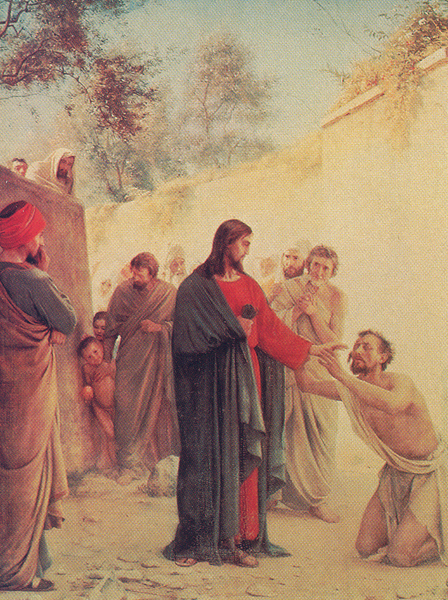
But to concentrate on these aspects of Jesus’ healing is really to miss the point. As previously noted, the New Testament itself recognizes that others too can effect miraculous cures. The stories of Jesus’ miraculous cures are intended to convey a religious message.
The healing miracles are public performances, so to speak, because ordinary people see them. But the nature miracles, the other category, are witnessed only by the disciples. Jesus’ nature miracles can be further subdivided into (a) those that demonstrate power over nature—for example, the stilling of a storm10—and (b) feeding miracles, such as the multiplication of loaves and fishes. Like the demonstrations of power over nature, the feeding of the multitudes is a private miracle. The crowd does not know where the food comes from. The people do not see a miracle and do not respond to one. The miraculous multiplication is perceived only by the disciples (Mark 6:38–44)
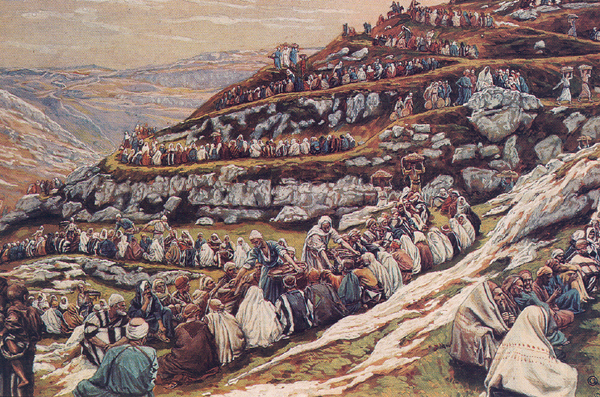
Jesus’ nature miracles obviously do not have the same claim to authenticity as the healing miracles.
Until the late 1700s, the nature miracle stories were generally regarded as reliable accounts. During the Enlightenment, scholars began to look for reasonable explanations of the miracle stories. Thus, the calming of the storm was explained by saying that the boat suddenly rounded a cape and moved leeward (in the wind’s direction). This kind of explanation totally misses the point: After all, a miracle is being described.
To understand these miracle stories, we must consider them symbolically. They are not intended to recount history, an actual event, but to convey a religious message.
To appreciate the story we must understand it in the context of Near Eastern mythology. This is the key to understanding the stories about Jesus stilling the storm and walking on water. In certain biblical texts, the roaring sea is an image of the powers of chaos, threatening the cosmos established by God. Although God was victorious over the powers of chaos when he created the world, the evil ones can rise again. The pious, however, need not be afraid: “We shall not fear, … though the mountains shake in the heart of the sea, though its waters roar and foam” (Psalm 46:2). When Jesus calms the wind and the sea, he utters a rebuke and commands the waters to be still (Mark 4:39). In the mind of the reader, this recalls the cosmogonic work of God: “The waters stood above the mountains. At your rebuke they fled, at the sound of your thunder, they took to flight” (Psalm 104:7). The answer to the disciples’ question, “Who then is this, that even the wind and the sea obey him?” (Mark 4:41), is: The Lord of creation.
The chaotic primordial waters that God subdued when he created the world could also be represented as a monstrous dragon. In Job 9:8 it is said that when God created the world, “he trampled the back of the sea dragon.”11 When Jesus walks on water, he too is being portrayed as the Lord of creation.
In some biblical texts, God’s power over water is associated with the divine miracle that occurred at the Red Sea: “With your strong arm you redeemed your People, the descendants of Jacob and Joseph. When the waters saw you, O God, when the waters saw you, they were afraid, the very deep trembled” (Psalm 77:15–16).12 Thus, when Jesus walks on water, he appears as the Lord of salvation as well as the Lord of creation. Just as God saved the Israelites at the Red Sea, Jesus saves his people from drowning. This is explicit in the miracle described in Matthew 14:28–33. There Jesus bids Peter to get out of his boat and walk on the water toward Jesus. He was able to do this until a wind made him afraid and he began to sink. Jesus catches him and then rebukes him: “O man of little faith, why did you doubt?” (Matthew 14:31).
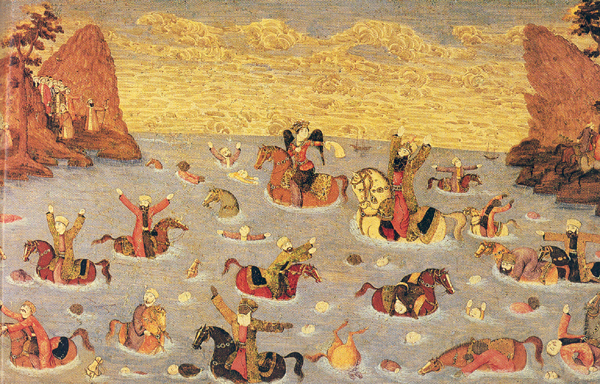
The feeding miracles must also be interpreted in a symbolic way. The feeding miracles in Mark are intended symbolically to replicate the story of the Last Supper. In each case, Jesus takes the bread, blesses it, breaks it and distributes it, and all those present partake of it (compare Mark 6:41–44 and 8:5–7 with Mark 14:22–25).
In addition to the eucharistic allusion, Jesus’ feedings of the multitudes also allude to the Exodus—specifically to God’s feeding of the Children of Israel in the desert on their way to the Promised Land (Exodus 16). The crowds reclining in groups of hundreds and fifties (Mark 6:40) are reminiscent of the Israelites assembling in groups of thousands, hundreds, fifties, and tens (Exodus 18:21).
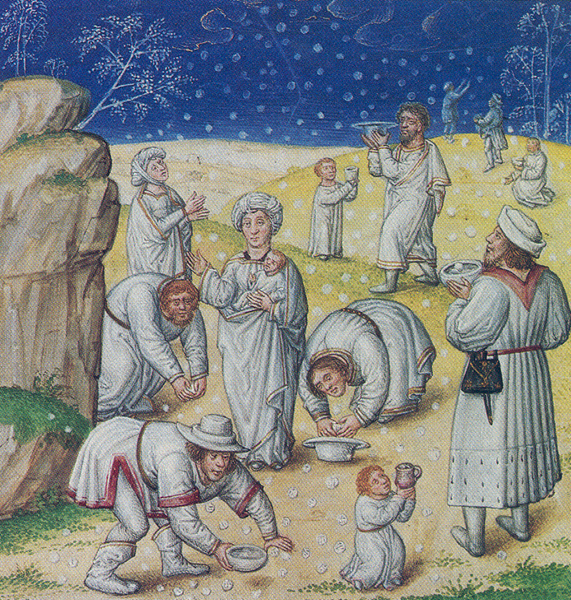
Both Jews and Christians regarded the feeding of the people in the desert as a prefiguration of the “messianic banquet” in the future Kingdom of God.13 Jesus makes an eschatological reference in the account of the Last Supper when he says that he will not drink wine again “until that day when I drink it new in the Kingdom of God” (Mark 14:25). The feeding miracles in the Gospels can thus be seen as descriptions of the consecration of Jesus’ followers as partakers in the coming messianic feasts.
Biblical form critics have noted that the healing miracles follow a certain pattern or form: First, the illness is described. The failure of physicians to effect a cure may also be noted. Second, the cure itself is related. Third, the proof of healing is noted—the lame start to walk, and so on. In cases of possession, as we have seen, the demons may be required to prove they have left the person. Finally, the impression of the miracle upon those witnessing may be recounted.14
It is sometimes charged that form critics maintain that the miracle stories were contrived, that miracles and the historical Jesus have nothing to do with each other. This reflects a misunderstanding of the form critical method and its scope. Rudolf Bultmann, the dean of form criticism, wrote that there could be “no doubt” that Jesus “healed the sick and expelled demons.”15 Formal similarity simply means that the early Christians reported Jesus’ miracles in the manner that miracles were supposed to be recounted. At most, form critical analysis demonstrates only that stories of the healing miracles attributed to Jesus were given their present literary structure at a relatively late stage. They are not eyewitness reports. This form critical analysis provides no basis, however, for asserting that Jesus did not perform any healings or exorcisms. On the contrary, it is very likely that he did.
On the other hand, it is also very likely that as time went by, the early Christians made Jesus into a greater miracle worker than he in fact had been. Jesus’ individual cures are not very numerous. An account such as we find in Mark 1:32–34 appears to be a nonhistorical extension:
“That evening at sundown, they brought to him all who were sick or possessed with demons. And the whole city was gathered at the door. And he cured many who were sick with various diseases, and cast out many demons.”
For Matthew, even this was not enough. Where Mark relates that all who were sick were brought to Jesus and he cured many, Matthew says that many who were sick were brought to him and he cured all (Matthew 8:16).
That, in the course of time, the early Christians portrayed Jesus as a greater miracle worker than he was, especially with mass cures, does not mean that he performed no miracles at all.
What is the message of Jesus’ healing miracles? That is the real question, not whether they happened in precisely the way they are described in the Gospels.
In the healing miracles, we are being told that the evil powers have had their time, and that time is now up. When the Gerasene demons are driven out, they exclaim, “What have you to do with us, Son of God? Have you come to torment us before the time?” (Matthew 8:29). The demons are fearful, for they have been defeated.
In Luke 10:17–18, the disciples tell Jesus, “Lord, in your name even the demons submit to us.” Jesus responds, “I saw Satan fall from heaven like a flash of lightning.” In other words, the submission of the demons is tantamount to the fall of Satan.
The healing miracles imply that God’s judgment has begun, that the end time is here, that the Kingdom is at hand.
Not everyone sees this. Even John the Baptist asks Jesus, “Are you the one who is to come, or are we to wait for another?” (Matthew 11:3//Luke 7:19). Jesus answers by pointing to his miracles: “The blind receive their sight, the lame walk, the lepers are cleansed, the deaf hear, the dead are raised, and the poor have the good news brought to them.” This answer is based on texts from Isaiah describing the age of salvation (Isaiah 29:18–19, 35:5–6, 42:7, 61:1). Thus, in Jesus’ healings, salvation is at hand; the Kingdom of God is breaking into the world.
While acknowledging Jesus’ powers, his opponents retort, “It is only by Beelzebub, the ruler of the demons, that this fellow casts out the demons” (Matthew 12:24//Luke 11:16). In short, miracles are ambiguous. They may leave people perplexed. They may even be regarded as performed by the power of Satan.
How are miracles to be understood correctly? Jesus concludes his answer to John the Baptist by saying, “And blessed is he who takes no offense at me!” In order to understand the miracles of Jesus, it is necessary to understand Jesus himself.
Who can understand Jesus? The key word is faith. Jesus could not perform miracles in his hometown, because people in Nazareth did not believe in him, although they did believe he could work wondrous deeds: “What deeds of power are being done by his hand!” (Mark 6:2) But they had no faith in the son of the carpenter. Because miracles are reserved only for those who have faith in Jesus, “He could do no deed of power there, … And he was amazed at their unbelief” (Mark 6:5a, 6a).
Immediately before the story of Jesus’ rejection in Nazareth, he performs two miracles, one by curing a woman with a continuous flow of blood and the other by raising a 12-year-old girl (the daughter of one Jairus) who had died (Mark 5:21–43). The hemorrhaging woman was convinced that if she could only touch Jesus’ outer garment, she would be cured. She believed this even though she had been hemorrhaging for over 12 years, had consulted “many physicians,” spent all she had and was getting worse rather than better. In this healing story, faith means trusting in Jesus—even though the situation appears hopeless. The woman experiences the miracle: By grasping Jesus’ garment, she draws power from him and is instantly healed.
According to the Law, her continuous flow of blood made her continuously unclean (Leviticus 15:25). She would not be allowed to touch other people. This is why she sneaks up on Jesus from behind. By grasping Jesus’ garment, she makes him unclean: consequently, he should have washed his clothes and remained unclean until sundown. Nothing of the sort happened. Instead, Jesus says to the woman, “Your faith made you well.” This statement may also be translated, “Your faith has saved you.” Unclean persons were isolated from God as well as from people. Since God is holy, unclean people were excluded from the Temple and the synagogues. When the woman is healed, she is taken back into communion with God. Her faith has not only healed her, but also saved her.
The same lesson is to be learned from the raising of Jairus’ daughter. When Jairus first pleads with Jesus to save her, she is at the “point of death” (Mark 5:23). By the time Jesus gets to Jairus’ house, the child is reported to have died: “Your daughter is dead. Why trouble the Teacher any further?” Jesus, however, says: “Do not fear, only believe” (Mark 5:36).
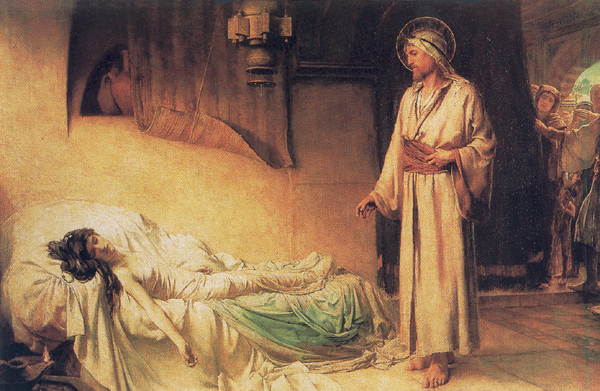
Of course it is possible to “explain” the story by saying that Jesus brought the girl out of a coma; this would be a rationalistic misunderstanding. Or it can be asserted that Jesus really did raise the girl from the dead—which would only reflect fundamentalist naïvetè As we have seen, raising the dead was not considered impossible in the ancient world. Greek miracle stories relate that even physicians witnessed raisings from the dead. Mark’s point, however, is that Jairus takes it seriously when Jesus says to him, “Do not fear, only believe” (Mark 5:36). It is by faith Jesus that death itself can be conquered. The real miracle in the story is the persisting faith of the father: Even when his daughter is dead, he continues to believe. The raising of the girl from the dead is a sign that death will not have the last say over those who believe in Jesus.
MLA Citation
Endnotes
H. Diels, Die Fragmente der Vorsokratiker, seventh edition (Berlin: Weidmann, 1954), Fragment 112.
Philostratus, Life of Apollonius 4:20 (transl. by C.K. Barrett, The New Testament Background: Selected Documents, revised edition (San Francisco: Harper, 1989), p. 83).
For hypnotism’s relevance to the healing practice of Jesus, see the survey by Ian Wilson, Jesus: The Evidence (San Francisco: Harper, 1988), pp. 102–113.
To the nature miracles must be reckoned the effective cursing of the fig tree (Mark 11:12–14, 20–25), a story that appears to embarrass the pious believer and the critical scholar alike.
See Bruce M. Metzger and Roland E. Murphy, ed., The New Oxford Annotated Bible (New York: Oxford Univ., 1991), p. 634 (Old Testament) note z. Compare 5:13 with annotation.
Compare Isaiah 51:9–11 with annotation in The New Oxford Annotated Bible, p.937 (Old Testament).
For the idea of the “messianic banquet,” see Isaiah 25:6 55:1–2, etc. In 2 Baruch 29:8, it is said that the “manna will come down again from on high” in the messianic age. Here, in a text from the beginning of the second century C.E., there is a reference to the feeding of the people in the wilderness.
See, for example, Rudolph Bultmann, Die Geschichte der synoptischen Tradition, 3rd ed. (Göttingen: Vandenhoeck & Ruprecht 1957), pp. 233–241
